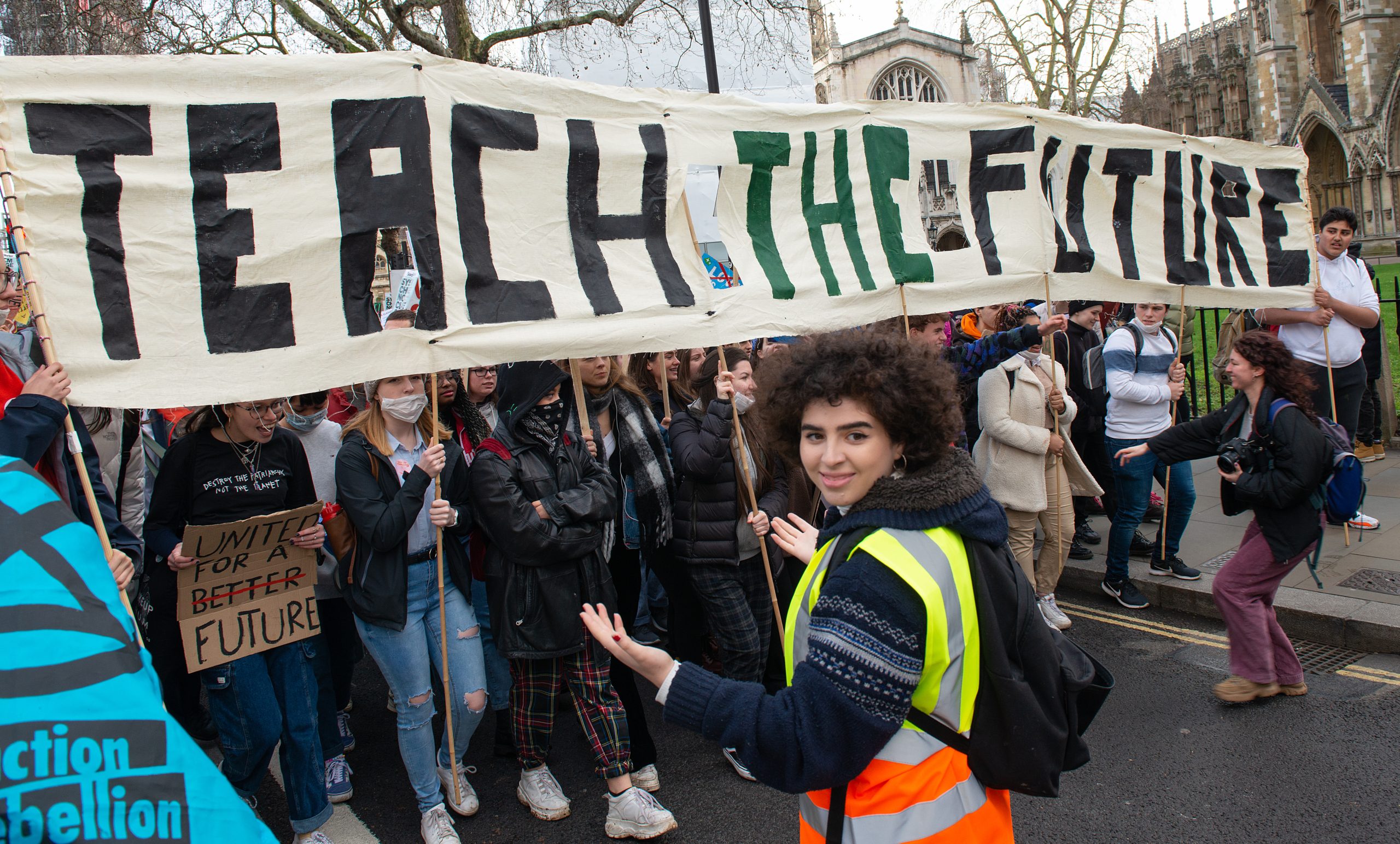 884
884  4 mins
4 mins Teach The Future believes that the current climate education is inadequate and has a plan for that.
The climate crisis is on a collision course with the youngest generations.
Many are questioning the fallout the unfolding crisis will have on the lives and livelihoods of those in school today.
Although the pandemic slowed many youth initiatives that began with the “School Strike for Climate” in May 2019, young people remain the driving force in demanding action and solutions to the climate emergency.
They understand that their futures are directly at stake.
So it is no surprise that students across the UK came together to organise a campaign called “Teach The Future”.
The idea is simple – schools need to do more to help students “prepare for and face the effects of climate change.”
Teach The Future has a plan.
They want climate change to become an integral part of school education in the UK.
“Education is the most powerful weapon
which you can use to change the world.”
Nelson Mandela
Teach The Future collected the results of a series of Climate Education surveys to develop a plan of action.
Among their findings was that 70% of teachers surveyed reported not having adequate training to educate students on climate change.
They understood that they were proposing more than a simple change in the curriculum.
They were actually fighting to revolutionise the UK education system.
To achieve this, they began lobbying nationwide with the launch of their campaign in December 2019.
Importantly, they also began involving MPs to sensitise the nation to the reality of the climate emergency.

Image Credit: John Gomez/Shutterstock
A crucial victory!
As a result of their efforts – most notably including a 2-year collaboration with the youngest member of Parliament, Nadia Whittome – Teach The Future made history.
On November 23rd, 2021, MP Whittome from Nottingham East presented the first-ever student-written bill to Parliament by reading the “English Climate Emergency Education Bill” in a 10-minute rule bill.
The bill, drafted by Teach The Future, was successfully received and passed forward for a formal introduction in the House of Commons.
It was a critical victory, and a crucial milestone for this student led organisation.
Young people have been calling for climate education in schools.
Alongside students from @_TeachtheFuture, I was proud to present the first ever student-written Bill to Parliament, which would make this law.
After working on this together for 2 years, today we made history. pic.twitter.com/6D6dJuogL7
— Nadia Whittome MP (@NadiaWhittomeMP) November 23, 2021
Problem-solving
The first step to solving any problem is identifying and describing the issues.
This is why teaching climate change is pivotal.
Teaching climate change helps students to begin to think about the problem.
“Sustainability and climate change need to be taught across the curriculum, equipping students with the skills and knowledge needed for the green jobs of the future.”
Teach The Future’s campaign proposes three main courses of action.
Teach students about climate change
The Teach The Future found that, in those schools where climate change is currently mentioned, it is primarily limited to either science (65%) or geography lessons (63%).
Teach The Future believes that climate education is a subject that should be embedded in all subjects taught at school.
They want it to become a “golden thread” that runs through all subjects taught, from primary to tertiary education.
The aim is to help students learn about sustainability, understand the causes and consequences of the climate emergency – and how to mitigate the crisis.
Include green skills in many vocational courses
In addition, Teach The Future is also advocating for vocational courses to include green skills as part of their training.
They aspire to develop a workforce capable of actively participating in reaching net-zero emissions and developing sustainable technologies.
Make educational buildings “climate-friendly”
Finally, by requiring new schools to be carbon neutral and retrofitting existing schools to be net-zero by 2030, they hope to create green jobs.
Teach The Future explains that climate-friendly buildings also have the added benefits of aligning with students’ aspirations to live a sustainable life as well as contributing to the climate pledges made by the UK at COP26.
View this post on Instagram
Mind the gap
The surveys also point to a significant divide.
While 68% of students say they want to learn more about the climate, 41% of teachers report that climate change is “rarely or never mentioned” in their schools.
And a majority of teachers report that the barriers they face to teaching climate change stem from feeling already overstretched with the compulsory elements of the schooling curriculum.
The English Climate Emergency Education Bill proposes addressing these issues.
It would require compulsory training for teachers to better educate future generations on the climate crisis.
The first reading of the Bill will take place on January 28th 2022.
It is the first stage of a multistage process.
Teach The Future continues to organise and mobilise to accompany the Bill on the long path it must take to be written into law.
View this post on Instagram
How to support Teach The Future?
Visit Teach The Future’s website to discover ways to support The English Climate Emergency Education Bill.
It is possible to sign the petition asking the government to implement broad climate education.
UK residents can also send a pre-filled “Write to your rep” form expressing support on climate education to their MP.
Teachers can join Teach The Future’s “Teacher’s Network“.
There are also opportunities to volunteer, donate money or simply read the comprehensive resources assembled by Teach The Future.
Teach The Future also keeps the world updated on their progress through their social media channels: Instagram, Twitter and Facebook.
Feature image credit: NeONBRAND/Unsplash
You might also like reading the story of the 2 sisters who started “Our Streets Now”, a nationwide campaign to make public sexual harassment illegal in the UK.


 https://www.dropbox.com/sh/m98w7crn7ie8wox/AAC7Xu4_o6V7w3a_znUXifQea/Weathered_Souls_Black_is_Beautiful_GRAPHICS?dl=0&preview=Weathered_Souls_Black_is_Beautiful_INSTAGRAM.ai&subfolder_nav_tracking=1
https://www.dropbox.com/sh/m98w7crn7ie8wox/AAC7Xu4_o6V7w3a_znUXifQea/Weathered_Souls_Black_is_Beautiful_GRAPHICS?dl=0&preview=Weathered_Souls_Black_is_Beautiful_INSTAGRAM.ai&subfolder_nav_tracking=1 https://www.shutterstock.com/image-photo/glowing-kelp-526412359
https://www.shutterstock.com/image-photo/glowing-kelp-526412359